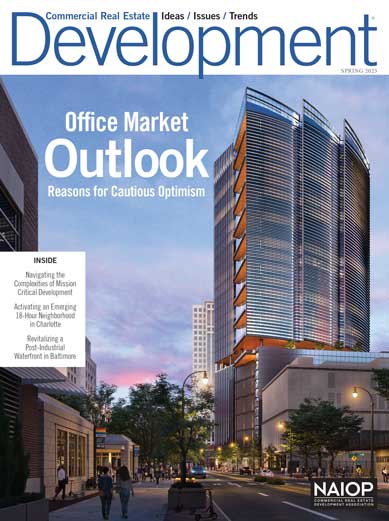Industrial Sector to Remain Strong in 2019 as Economy Steadies
The NAIOP Industrial Space Demand Forecast sees few changes from 2018.
New Albany, about 15 miles northeast of downtown Columbus, maximizes the planning process to beat major cities in the development sweepstakes.
The NAIOP Industrial Space Demand Forecast sees few changes from 2018.
As densities increase, environmentally advanced infrastructure and systems can help developers manage runoff in cities.
A reliable cellular and data network will be vital for a wide range of businesses and other activities.
A Nashville-area mixed-use development illustrates the uplifting potential of landscape architecture.
With acres of open space in prime locations, abandoned golf courses can be ideal spots for infill warehouse and distribution facilities.
Analytics can guide store size and configuration, help save money and improve customer engagement.
Awash in granular digital information, companies are diving headfirst into high-tech solutions so they can make more deeply informed business decisions.
Interconnected security systems help make for safer, more efficient facilities.
 Fall 2025 Issue
Fall 2025 Issue
Development’s fall issue features a profile of Vulcan Real Estate, NAIOP’s 2025 Developer of the Year. Also included: an innovative adaptive reuse project that transformed an iconic former Sears store into modern multifamily residences; a look at how baby boomers are changing the senior living market; and the influence sports and entertainment districts are having on urban real estate.
 Summer 2025 Issue
Summer 2025 Issue
Development’s summer 2025 issue explores experiential retail and the brick-and-mortar resurgence. Also featured: a modern warehouse campus in Toronto that honors its manufacturing heritage; a coalition of Oregon real estate organizations working to revitalize downtown Portland; and the creative capital stack strategy behind a mixed-use project in West Baltimore.
 Spring 2025 Issue
Spring 2025 Issue
The spring 2025 issue offers insights about where the office market might be heading over the coming year, explores the complexities of mission critical development, and provides detailed looks at two transformative mixed-use projects: The Bowl at Ballantyne in Charlotte and Baltimore Peninsula in Maryland.
